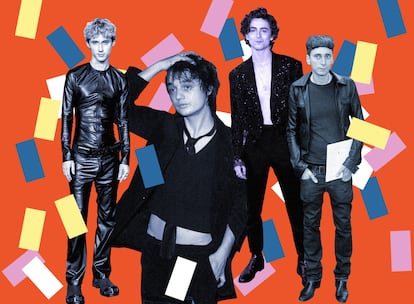Thin, sloppy, addicted and tyrannical: The most controversial fashion trend returns
The ‘indie sleaze’ esthetic — made trendy by problematic icons such as Pete Doherty — returns to film, music, and festivals. However, this time around, the style comes with a warning about not repeating the poor ethics that seem to accompany it

Toasted bread with cheese was what the “indie sleaze” star lived on. He also consumed a narcotic-alcoholic rehabilitation program, but, above all, bread with cheese was the staple meal. And yet, despite this frugal diet, there he was, front row at the CELINE show in Paris this past February, an embodiment of the official return of the attitude (or movement, culture or subculture, whichever you prefer): Pete Doherty.
Doherty — best known as the co-frontmant of The Libertines — still has a lot to say about that past moment of poetry, drugs and skeletal rock romanticism that is now coming back in style. At the end of September, the Zurich Film Festival will host the premiere of Stranger in My Own Skin, a documentary directed by the French filmmaker and musician Katia de Vidas (also Doherty’s wife and the mother of his third child). It will look at the musician’s infamous days with Carl Bârat in The Libertines and his time with Babyshambles.
“I had no idea it had been labeled a fashion phenomenon, but I happily agreed. I’ve been the visible head of indie sleaze for years!” he answered jokingly, when asked about the style by the weekly NME during his appearance at the Glastonbury Festival in 2022, where he also reunited with Bârat. Thus returns the stylistic manner and interesting hairstyles that a previous generation indulged in, with the viral hashtag #indiesleaze appearing all over TikTok and Instagram. A visual archive of the “mid-late 2000s decadence and party scene that died out in 2012″ is suddenly circulating again. In December 2022, The Lyst mentioned it as a trend to take seriously in 2023 — a prediction that ultimately came true.
After the glorification of the Y2K esthetic, it’s now time to recover the t-shirts with ironic slogans (Henry Holland’s, for example, worn by Agyness Deyn — the model, muse, and girlfriend of guitarists, who, today, is a cult actress), wrinkled leather jackets, Ray-Ban Wayfarers and skinny jeans. We can wallow in the snapshots of Mark Hunter — alias Cobrasnake and the official photographer of indie sleaze — or admire the ability of Cory Kennedy — the first “it” girl of the internet, the queen of MySpace — to dress as if she just rolled into the dirty clothes piled on her bed.

The British writer Rihannon Lucy Cosslett recently recounted a tremendous scene from the original indie sleaze era, in her column in The Guardian: “My greatest memories include starving myself to fit into the requisite uniform of cut-off jeans, ghosting guys ten years older than me, smoking Topshop cigarettes and stuffing so many drugs up my nose that my right nostril is still numb.” She was a slim, white, conventionally attractive girl, welcomed into that hedonistic universe where boys with a band were kings and sad girls their courtesans. “We forgave everything — their theft of money to buy drugs, their serial infidelities, the rampant misogyny — so long as they didn’t call us boring.”
Cory Kennedy — who went through several mental institutions when the party ended — can also attest to this. “I was never in control of the narrative,” she confessed, in an interview with The Cut this past April. “The club’s favorite slut” is what LA Weekly sneeringly called her. Those were different times — before #MeToo, it can be argued. Perhaps, but the same ghost is crouching behind the revival of joyous indie filth, spurred on by the voracious, youthful appetite for the streets and partying following the pandemic.
“They all want to date the boys in the band / They squirm and scream for the boys in the band,” The Libertines bellowed in their generational anthem, Boys in The Band. Of course, it was always about them: the guys with greasy hair, poetic verbiage and eyes like slaughtered lambs, barely a foot of meat between their chests and their backs. If Y2K points to the infantilization of women — condemned to be extremely thin, vulnerable and sexualized — indie sleaze points to a similarly romanticized male counterpart. This ideal has permeated fashion since Hedi Slimane began to shape it in the late 1990s, as creative director of Yves Saint Laurent’s Rive Gauche line.
“I’m not interested in classical beauty, but rather a certain grace and vibrancy, a deep sense of personal style and a powerful face. This is how I introduced a different idea of masculine identity and beauty into men’s fashion,” the French designer told the American journalist Lizzy Goodman, in a conversation that was included in CELINE’s Age of Indieness Fall/ Winter 2023-2023 collection, which was initially unveiled at the Wiltern Theater in Los Angeles.
We owe Slimane for creating the biggest shift in the male silhouette over the last two decades. He rejuvenated it during his tenure as the creative director for Dior Homme, by using male models with tiny features, conforming to the canon of the emerging electronic dance phenomenon. “The guy on stage was the guy on my catwalk,” he revealed, to no one’s surprise. And with this came the new canon, in an ephebic and meager format. “I’ve never had an orthodox idea about what a [male] model — or any guy in general — should be like. For me, it has always been about a strong, determined mind, under the guise of vulnerability; a balance between masculinity and femininity as fictional as it is natural, [along with] a complete lack of definition in terms of gender.”
“In the late-1990s, tolerance for a body that wasn’t muscular or athletically toned was very limited, to say the least. My models were all androgynous. [They hailed from] a new indefinite identity that I openly defended. So, a fine, slender body identified as gay, and the reactions to the casting of my shows weren’t free of homophobia. Until, years after starting Dior Homme, my idea of a male model spread through the industry and the standards changed,” he explained to Goodman.
CELINE’s presentation in Los Angeles — including performances by The Strokes, Interpol and Iggy Pop — served to recall the creative muscle of the designer of the sad figure. And, back in February, his men’s collection for the upcoming season was previewed at the legendary Parisian club Le Palace. All of this confirmed that the days of the rocker with the downcast eyes, dirty hair and bony anatomy are back. Even Prada, Saint Laurent, Diesel or Gucci have jumped on the bandwagon. Television, meanwhile, has seen The Idol — the already-canceled HBO series — convey (with a twisted male gaze) a very thin Lily-Rose Depp.
The singer Troye Sivan — one of the protagonists of indie sleaze — found himself immersed in a small controversy this past July, and not only because of the null body diversity exhibited in his latest music video, Rush. He was also scolded because of the excessive thinness of some dancers who, however, were a festival of gender inclusion. “Eat something, stupid twinks,” reproached a critic from Vulture, who went on to warn about the return of “body fascism and the culture of thinness.”
The Australian musician — who has suffered from body-shaming due to his own scant physique — defended himself: “Obviously, we never said: ‘We want a specific type of person.’ We just recorded the video.” Meanwhile, Timothée Chalamet — who was recently seen smoking a cigarette with Kylie Jenner at a Beyoncé concert — epitomizes this trend.
Pete Doherty — the man who may be the godfather of all of this — has a somewhat bizarre conclusion about his relationship with all this: “As long as I’m still this fat, I don’t have to worry. There are no fat junkies.”
Sign up for our weekly newsletter to get more English-language news coverage from EL PAÍS USA Edition
Tu suscripción se está usando en otro dispositivo
¿Quieres añadir otro usuario a tu suscripción?
Si continúas leyendo en este dispositivo, no se podrá leer en el otro.
FlechaTu suscripción se está usando en otro dispositivo y solo puedes acceder a EL PAÍS desde un dispositivo a la vez.
Si quieres compartir tu cuenta, cambia tu suscripción a la modalidad Premium, así podrás añadir otro usuario. Cada uno accederá con su propia cuenta de email, lo que os permitirá personalizar vuestra experiencia en EL PAÍS.
¿Tienes una suscripción de empresa? Accede aquí para contratar más cuentas.
En el caso de no saber quién está usando tu cuenta, te recomendamos cambiar tu contraseña aquí.
Si decides continuar compartiendo tu cuenta, este mensaje se mostrará en tu dispositivo y en el de la otra persona que está usando tu cuenta de forma indefinida, afectando a tu experiencia de lectura. Puedes consultar aquí los términos y condiciones de la suscripción digital.










































